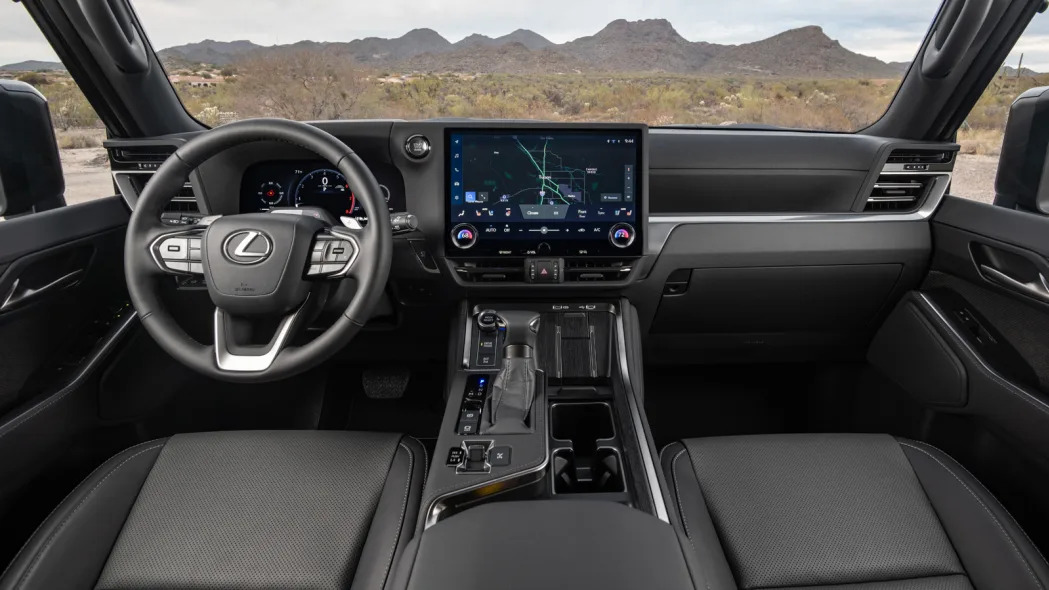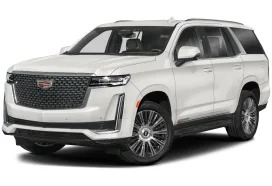The 2024 Lexus GX design is as clean-sheet as it gets; one that’s not just a complete departure from its excessively long-lived predecessor that wore multiple corporate faces, but one from the rest of the Lexus lineup as well. To these eyes, it’s one of the best-looking SUVs of all time. Clean, modern, classic. If it manages to survive the same 14 years as the last GX, it’ll still look great in 2038.
In concept, though, the new Lexus GX 550 is fundamentally the same: a luxury-lined, body-on-frame, three-row SUV that can actually go off-road. It’s just that it now looks the part, as opposed to the Kardashianland grocery-getter vibe it replaces. And sure, the Premium and Luxury trims are still more Patagonia brand than overlanding in actual Patagonia, but for that, the new GX 550 Overtrail exists. With its all-terrain tires on black 18-inch wheels, raised roof rails and serious mechanical upgrades, it represents the new vibe at its fullest.
To be clear, though, even if the concept carries over, nothing else does. You name it, it’s new, a reflection of a nameplate that basically skipped an entire generation of progress. The 2024 GX 550 is as modern as the GX 460 was ancient. Its GA-F platform is the same body-on-frame one that underpins the Lexus LX 600, plus Toyota’s Tundra, Sequoia, Tacoma and next-generation Land Cruiser. The resemblance to that last one is most obvious, as you can see below. It wouldn’t be a stretch to describe the GX as the Lexus Land Cruiser.


The new engine is a 3.4-liter twin-turbo V6 good for 349 horsepower and 479 pound-feet of torque. For those lamenting the loss of the old GX 460 V8, just know the hill you’re dying upon made only 301 hp and 329 lb-ft. It was also shackled to a six-speed automatic and could tow only 6,500 pounds. The new one has 10 speeds and can tow more than 9,000 pounds. There will also be a hybrid available “at a later date” comparable to, but presumably more powerful than, the Land Cruiser’s standard i-Force Max four-cylinder hybrid powertrain.
The difference is obvious and immediate. Before it was all sound, no fury; just a bunch of breathy roar on the way to a leisurely 7.7-second 0-60 time. Lexus hasn’t released a 0-60 time for the GX 550, but the VBox in my brain says it’s now in the mid-6 range, and better still, attached to a smooth, torque-rich powerband that speaks to both the performance and refinement demanded of a luxury SUV.
Fuel economy is estimated to be 15 miles per gallon city, 21 mpg highway and 17 mpg combined, so that’s not very good. The old V8 and six-speed got 16 combined. Meanwhile, a six-cylinder Land Rover Defender 110 returns 20 combined; a Discovery with the same engine gets 22 combined. I think we know what the first “con” is.
Every version of the GX 550 gets a full-time four-wheel-drive system, which, for most buyers, can be thought of as a typical all-wheel-drive system that’ll send power where it needs to when it needs to without driver interaction. It’s ultimately four-wheel drive because of the little switch that toggles the system from default 4Hi down into 4Lo. The changeover happens quicker now, though you still need to stop and put the GX in neutral. There is also a standard limited-slip locking center differential from Torsen that evenly splits power 50:50 for certain low-grip situations (that does not mean engage it when snowy).
That brings us to the Overtrail and its better-equipped sibling, Overtrail+. They gain an electronic locking rear differential, activated by the driver pressing a button, which evenly splits power between the rear wheels. If you enjoy a good afternoon of rock crawling, you’ll appreciate this. If you don’t, well, it’s there.
By the way, all of the above off-road hardware is standard on the new Land Cruiser. Unique to the GX Overtrail is its standard Electronic Kinetic Dynamic Suspension System, or E-KDSS, which makes its debut in the Toyota/Lexus empire. The original, hydraulic version of KDSS was previously standard on every GX and available on the 4Runner TRD Off-Road, and accomplished the same overall goal as the new, electronically controlled version: automatically disconnecting the stabilizer bars when it detects you’ve reached an off-road obstacle that demands as much wheel articulation as possible. Because it can disconnect the roll bars, however, the roll bars themselves can be considerably bigger, allowing for improved handling and reduced body roll on-road. Simply, it’s a win-win. In-depthly, you can read everything you ever want to know about KDSS in our 4Runner Suspension Deep Dive.
The new electronic element allows increased suspension travel as well as the separate engagement of the front and rear stabilizer bars. This allows the rear bar to remain engaged until the system computer, based on a calculation of speed and wheelbase, determines that the same obstacle that just disengaged the front bar has reached the rear. To demonstrate why this is good, Lexus constructed an off-road obstacle consisting of a big hump for the left wheel and a deep puddle right next to it for the right wheel. While the resulting show outside was no doubt wheels dramatically going in opposite extremes, the experience inside was remarkably uneventful. The flat hood remained close to even with the horizon (thanks disconnected front stabilizer bar), while the rear end didn’t sway back and forth loosey-goosey (thanks to the still-connected rear stabilizer bar). At an appropriate snail-like pace, it felt like the Overtrail had gone over nothing at all.
The Overtrail also includes an adaptive variable suspension, available on the other trims, which does the usual trick of firming up for improved handling and relaxing for cushier goings. If the latter is important, you may want to think twice about the Overtrail, as the rigid sidewalls of its all-terrain tires degrade ride quality – going from the volume-selling Premium+ trim to an Overtrail felt like swapping work boot rubber onto the soles of your running shoes. Yes, even though the other trims come standard with 20-inch wheels. We didn’t detect an overt increase in road noise, though, and really, the ride was still well within the realm of acceptable. It’s just less traditionally Lexus-like.
That’s not the only potential downside to the Overtrail: It’s five-passenger only. The Premium and Luxury trim levels have three rows, with a standard seven-passenger capacity or optional six-passenger/captain’s chairs. Third-row space is actually decent – small adults and teens should fit back there well enough, and honestly, few luxury three-rows are better. Cargo space behind it, however, is LOL. The specs say 10.3 cubic feet, but that’s almost entirely vertical space. If any of the six bags from my luggage tests fit behind the third row, I’d be shocked. But at least you now get to it with a power-operated liftgate rather than the GX 460’s right-to-left swing gate. Some will be sad, most will not, but all will be happy it still has a separate pop-up window. The liftgate was a widespread customer request.
Speaking of which, the Overtrail does not have the third row because Lexus research determined that overlanders frequently removed the GX 460’s third row for increased cargo capacity. Indeed, the Overtrail has 45.6 cubic-feet behind its second row versus 40.2 in everything else. That’s not nothing, but Lexus is expecting 30% of GX 550 customers will choose Overtrails. Of that, how many do you reckon are overlandists? It’s not surprising, then, that Lexus has already received feedback from would-be buyers who would like the option of a three-row Overtrail. Lexus is listening, don’t be surprised if it’s added sooner rather than later.


The rest of the cabin is tall and airy, with exceptional visibility thanks to the boxy shape, low beltline, relatively thin pillars and a blocky hood that drops down in the middle to provide a great view of the road ahead. And if all that suspension articulation stuff made you go “who cares?” know that the GX is still very much a luxury SUV. There are features aplenty, ranging from USB ports for every outboard seating position to massaging front seats. The same duo of 10.9-inch instrument screen and 14-inch infotainment touchscreen found elsewhere in the Lexus lineup lands in the GX (though it thankfully does without the absurd head-up display wheel controls available in the RX and NX). The touchscreen possesses the same foibles – no quick escape from Apple CarPlay, and the navigation map always forgets you set it for North Up after jumping to another menu – but it’s quite obviously an improvement over the ancient, embiggened 4Runner touchscreen found in the GX 460. Funny, that stayed on sale so long, multiple generations of Lexus Remote Touch came and went. Bullet dodged, I suppose.
Cabin build quality seems to be up to the usual elevated Lexus standards, but the materials themselves are a tad too Land Cruiser. Wood trim is unconvincing and haphazardly placed; the black squishy stuff on the passenger side of the dash looks like inexpensive hard plastic and, in general, the look isn’t as elevated as some might expect for the brand. Nor is it as characterful as the exterior. Leather isn’t standard, either, but the NuLuxe simulated stuff should wear better and didn’t take out a cow.


Perhaps it’s not obvious because of how much new-and-notable ground there was to cover, but the 2024 Lexus GX 550 is a profoundly likable SUV. It looks truckier, but the driving experience is considerably less so thanks to more direct and precise electronic power steering, a body less prone to heaving through corners, and an engine that smoothly doles out abundant power. It’s not as refined on-road as crossover-type three-row SUVs such as the new Lexus TX, but the gap has shrunk dramatically. Positive comparisons to the Land Rover Defender are warranted, and not just from an objective perspective. The GX 550 similarly tickles the subjective parts of the brain with its own classic, off-roader style that’s so very “now.”
That Lexus is bullish about its sale potential is no surprise – if anything, the estimate of 33,000 from the second quarter onward is conservative considering ye olde one sold nearly 32,000 with an extra quarter to work with in 2023. Constraints on the factory in Japan are more likely to be a limiting factor than demand, especially as roughly 30,000 people have already raised their hands. In other words, good luck finding one!
But if you do, the 2024 Lexus GX 550 is unlikely to disappoint, even with the lofty expectations that come with looking so darn good … and waiting so darn long. It’s a better luxury SUV and it’s a better off-roading SUV. It’s not the most family-friendly nor the most efficient, but then nothing’s perfect. If this is what we’ll be stuck with for the next 14 years, that should be just fine.
















Sign in to post
Please sign in to leave a comment.
Continue